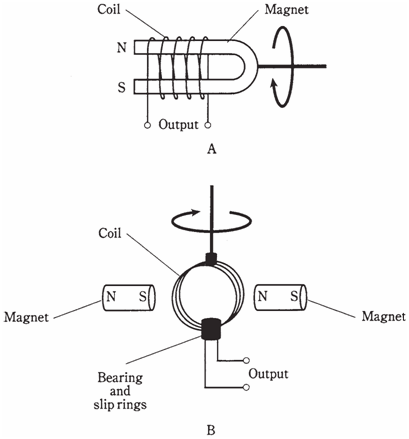AC generator
Alternating current is easily generated by means of a rotating magnet in a coil of wire, or by a rotating coil of wire inside a powerful magnet. In either case, the ac appears between the ends of the length of wire.
The alternating current voltage that a generator can develop depends on the strength of the magnet, the number of turns in wire coil, and speed at which the magnet of coil rotates. The alternating frequency depends only on the speed of rotation. Normally, for utility alternating current, this speed is 3,600 revolutions per minute, or 60 complete revolutions per second, so that the frequency is 60 Hz.

Figure Two forms of ac generator. At point A, the magnet rotates; at point B, the coil rotates.
When a load, such as a light bulb or heater, is connected to an alternating current generator, it becomes more difficult to turn the generator. The more power required from a generator, the greater the amount of power is needed to drive it. This is it is not possible to connect a generator to, for instance, your bicycle which is stationary, and pedal an entire city into electrification. There is no way to get something for nothing. The electrical power which comes out of a generator can never be more than the mechanical power driving it. Actually there is always some energy lost, majorly as heat in the generator. Your legs may generate 50 W of power to run a small radio, but nowhere near enough to provide electricity for a household.
The efficiency of a generator is the ratio of the power output to the driving power, both measured in the same units, multiplied by 100 to get a percentage. No generator is 100 % efficient. But a good one can come fairly close to this ideal.
At power plants, the generators are huge. Each of them is as big as a house. The generators are driven by the massive turbines. The turbines are turned by several natural sources of energy. Frequently, steam drives the turbines, and steam can be obtained via heat derived from natural energy source.